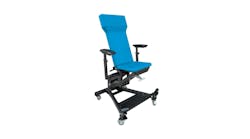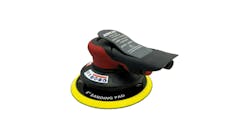As important as it is to have advanced driver assistance systems (ADAS) features for the front of a vehicle, having safety features out back is just as vital. When you think about it, we as drivers spend most of our time looking forward, (at least I hope you do). Seeing behind us is not only secondary, but also more difficult because there are obstructions to our rearward view such as pillars, head rests, and occupants.
With all of these obstructions, one of the more difficult driving maneuvers for many is parking. However, with ADAS, there are a few systems to help with that daunting task. Those systems are park assist, active park assist, and the rearview camera.
Park assist
Park assist has been around for many years, first appearing in the early 2000s, the technology has not really changed much. Typically consisting of numerous ultrasonic sensors in the rear bumper or both the front and rear bumpers, the sensors send out a sound and “listen” for that sound to bounce back to the sensor. The time it takes for the sound to reflect off of an object and return to a sensor is used to calculate the distance between the object and the vehicle.
Park assist systems can have various ways to alert the driver, but virtually all produce an audible warning to alert the driver that the vehicle is closing in on an object. Typically, the alert is a simple beeping noise. Often this beep will become more rapid as the distance between the vehicle and an object reduces and will eventually become a steady tone once the distance is below a specific threshold. The distance at which this happens can vary between OEMs and even between models within an OEM.
In most cases it is up to the driver to heed these warnings and brake as needed. However, in some systems, rear automatic braking may be available to stop the vehicle in the event the driver fails to do so. This kind of vehicle autonomy brings us to the next level of parking assist, active park assist.
Active park assist
Active park assist, as the name implies, involves an action or actions by the vehicle to aid in parking. Again, these systems generally work on the same principles across OEMs but can have differences in the operation and execution of how they assist the driver. For example, some vehicles will steer, brake and accelerate as needed, while others will only steer, keeping the braking and accelerating functions to the driver. Some more advanced systems can even change gears, put the vehicle in park, and apply the parking brake.
Just like the park assist systems, active park assist systems typically use sensors in the front and rear bumpers. However, they often include additional parking sensors that are oriented to the sides of the vehicle. These sensors may be mounted in the bumpers or may be in a different location, such as in the fender of the vehicle. These additional sensors aid not only in automatically parking the vehicle without colliding with objects, they can also be used to locate and identify an open parking space and determine if it is large enough for the vehicle to fit in.
It is important to note that parking sensors are not designed or intended to identify smaller objects like pedestrians, motorcycles, and bicycles, so it is important that the driver remains alert to their surroundings.
Ultrasonic parking sensors, by design, are precise devices that can be affected by anything that covers them. As sound travels at different speeds through different materials, having snow, mud, and even excess paint on a sensor will affect the speed at which the emitted sound will travel. This change in the speed of the sound will in turn affect the accuracy of the parking system. As a driver it is important to make sure the sensors are clear of debris. As a technician, it is important to be aware of what can and can’t be done with the parking sensors.
Some OEMs allow painting or repainting of the surface of the sensor, while others do not. Some require calibration of the sensors after removal or replacement (this may also include bumper cover removal). Others may only require a function test be performed with objects placed at specific distances to verify the sensors are detecting as intended. It is important that sensors are installed correctly in the bumper and that retaining tabs are not broken or missing, as this may change the angle at which the sensor sits in the bumper cover. Improper installation of the bumper cover can also affect the position of the sensors and cause them to give false alerts or worse yet no alert.
Rear view camera
One other item that aids in the parking of a vehicle is the rear view camera. Often called a backup camera, it is typically only on when the vehicle is in reverse but may be on while the vehicle is in a forward gear under certain circumstances. This camera aids in viewing behind the vehicle and can help with parallel and other parking scenarios.
These camera systems may simply display the image directly behind the vehicle or they may have lines overlaid on the video image. These lines can be stationary or may be dynamic, meaning they will bend and curve as the vehicle is turned. The lines indicate the width of the vehicle, and there may be lines that indicate different distances behind the vehicle.
These lines are there to aid the driver in reversing and parking maneuvers. The camera (with or without guidelines) may work in conjunction with park assist and active park assist systems, or they may work independently of them.
Rear view cameras may require calibration if removed or replaced. Often you will find that if the rear view camera is part of a 360° camera view system it will require calibration, whereas if it is a stand-alone camera it may not. This is not a general rule, and calibration requirements for ADAS should always be verified in the vehicle-specific service manual.
In some cases, the camera may not require calibration or adjustment, but the overlay lines may. This can be a process that is done through a scan tool or in some cases it is performed through the vehicle infotainment screen. Just as it is important to have the camera properly aligned, it is important that the overlay lines are properly adjusted. As with any ADAS on a vehicle, the drivers expect the camera and parking system to function as it did before the vehicle was involved in a collision or otherwise repaired.
Knowing how park assist, active park assist, and rearview camera systems function and what calibration or other aligning requirements are required is essential to help ensure a complete, safe, and quality repair.
Editor’s Note: Miss any of Dirk’s ADAS articles? Click here for prior articles. Also, have you checked out I-CAR free online ADAS Portal for All Things ADAS – from news to webinars and podcasts: https://info.i-car.com/adas




